Sedimentary architecture of the Holocene mud deposit offthe southern Shandong Peninsula in the Yellow Sea*
2018-04-02QIUJiandong仇建东LIUJian刘健XUHong许红ZHOULiangyong周良勇
QIU Jiandong (仇建东) LIU Jian (刘健) XU Hong (许红) ZHOU Liangyong (周良勇)
1 The Key Laboratory of Marine Hydrocarbon Resources and Environment Geology, Qingdao 266071, China
2 Laboratory for Marine Geology, Qingdao National Laboratory for Marine Science and Technology, Qingdao 266061, China
3 Qingdao Institute of Marine Geology, Ministry of Land and Resources, Qingdao 266071, China
1 INTRODUCTION
Shelf mud deposits can be found on continental shelves worldwide, mainly on shelves with abundant terrestrial sediment supply and often in the form of elongated mud belts distributed along the coastline(Gao and Collins, 2014). The formation of mud deposits in shallow water is mostly associated with river input (Wang et al., 2014), such as the large shelf mud deposits associated with the Amazon River(Anthony et al., 2010), the Changjiang (Yangtze)River (Xu et al., 2012), the Huanghe (Yellow) River(Liu et al., 2007) and the Po River (Niedoroda et al.,2005). These Holocene deposits are 30–50 m thick.Other examples include shelf muds associated with the Niger (Riboulot et al., 2012), the Mekong (Tamura et al., 2012), the Red (van Maren, 2005), the Zhujiang(Pearl) (Owen, 2005), the Keum (Lee and Chu, 2001),the Eel (Curran et al., 2002), and the Waipaoa (Gerber et al., 2010) rivers.
The mud deposits that wrap around the end of the Shandong Peninsula in the Yellow Sea has been discussed in detail since it was first noted in the 1980s(Qin and Li, 1986; Milliman et al., 1989; Qin et al.,1989b; Alexander et al., 1991; Cheng et al., 2001; Liu et al., 2002, 2004, 2007; Yang and Liu, 2007). The proximal and distal phases of clinoform development were identified by Liu et al. (2002, 2004) in terms of the distance between the Huanghe River mouth and the clinoform during the postglacial transgression.Recent studies have revealed a unique Huanghederived, alongshore distributed, bidirectional(landward and seaward) across-shelf transported,omega-shaped (“Ω”) distal subaqueous deltaic lobe deposited around the eastern tip of the Shandong Peninsula and shown the detailed isopach of the Holocene sediments (Yang and Liu, 2007), and stratigraphy and environmental changes during the Holocene off the northern Shandong Peninsula (Liu et al., 2007). Qiu et al. (2014) reported the existence of a Holocene subaqueous clinoform off the southern Shandong Peninsula, which is distributed along the coastline in bands and in fan shapes at the mouths of some bays.
Despite these studies, our knowledge of the mud deposits off the southern Shandong Peninsula has been limited, especially about how these deposits link together. There are only a few profiles in the Jinghai Bay area (Fig.1b, blue lines), where a subaqueous delta (Yang and Liu, 2007) combines with a subaqueous clinoform (Qiu et al., 2014), so the actual distribution and architecture of mud deposits in this area remain unclear. In this paper, we discuss the high-resolution seismic structure of the Yellow Sea off the Shandong Peninsula, as well as other sedimentological and oceanographic data, which collectively allow us to examine the provenance and history of these mud deposits. These results will be of great significance to reveal the sources and sinks,interactions between land and sea, paleoenvironmental evolution in response to the sea level changes
2 PHYSICAL SETTING
The Yellow Sea is a shallow, post-glacially submerged epicontinental sea above a flat, tectonically stable shelf with water depth is no more than 100 m(Fig.1a). The South Yellow Sea reaches about 700 km in width and deepens toward the Yellow Sea Trough,defined by the 80 m isobath that is oriented NW-SE(Qin et al., 1989b). The floor of the western part of the South Yellow Sea is made up of four geomorphologic units from north to south: the Shandong mud wedge(Liu et al., 2004, 2007); an erosional area south of the Shandong Peninsula; the Old Huanghe River Delta,an abandoned subaqueous delta formed between 1128 and 1855; and the Jiangsu radial tidal sand ridges.
The Shandong Peninsula has an indented coastline with many bays (Fig.1b). The Qinglong River and other seasonal short streams contribute an annual sediment discharge of 15×104t to Jinghai Bay. The Rushan and Juhe Rivers discharge (30–50)×104t sediments into Rushan Bay annually. The Wulong River, which is about 124 km long, contributes average 84×104t sediments to Dingziwan Bay (data from 1958–1980). Besides, seasonal short streams empty (2.31–3.90)×104t sediments into Aoshan and Xiaodao bays annually. The Dagu River, which is the largest river on the Shandong Peninsula, empties into the Jiaozhou Bay. Its main channel can reach 180 km in length, and contributes an annual sediment discharge of 95.9×104t to Jiaozhou Bay historically.However, its middle and lower reaches have run dry since the late 1970s except during flood seasons(Editorial Board of Annals of Bays in China, 1993).
The modern Huanghe River presently discharges into the western Bohai Sea, and its sediment can be transported into the North and South Yellow Sea by coastal currents. The course of the Huanghe River has changed frequently during the Holocene, and in a period from 1128 to 1855 AD, the river shifted south of the Shandong Peninsula and discharged into the South Yellow Sea (Zhang, 1984).
3 MATERIAL AND METHOD
More than 300 km of high-resolution seismic profiles and 18 surface sediment samples were acquired off the southern Shandong Peninsula in October of 2013 (Fig.1b). The seismic profiles were acquired using SBP/AAE high-resolution profiler made by Applied Acoustic Engineering Company,UK. All seismic data were obtained with a pulse energy of 400 J fired at 800 ms intervals and a frequency band of 500–5 000 Hz. The seismic grid consists of 5 main profiles trending N-S and 2 connecting profiles trending W-E. The surface sediments were sampled with a grab.
Depositional sequences and bounding surfaces(onlap, downlap, truncation, and toplap) were identified from reflector characteristics in the seismic data. An acoustic velocity of 1 550 m/s was used to calculate the sediment thickness based on previous drilling and seismic experience.
A borehole core (QDZ03), 40.20 m in length, was obtained on the seismic line by the rigging method(Fig.1b) in May 2011 by drilling vessel Kan 407. The core site (36°16′03.21″N, 120°56′58.77″E) is located in muddy sediment at a water depth of 15.50 m.Recovery of mud-dominated sediments in the core was over 87% on average; recovery of the reaming intervals was generally 60% to 90%. In the laboratory,the core was split, described and subsamples. AMS14C dating was conducted on molluscan shells and foraminiferal tests using accelerator mass spectrometry (AMS) on equipment from Beta Analytic Inc. (Miami, FL, USA; Qiu et al., 2014).

Fig.1 Location of the study area (a); the Yellow Sea and East China Sea are marginal seas off the China coast; the tracklines of the high-resolution seismic profiles (b)
We collected another borecore WHZK01 at a water depth of 15.80 m in this study area (Liu, 2016; Liu et al., 2016). The core site (36°26′N, 123°23′E) is located in muddy sediment on the seismic line(Fig.1b) and the average recovery of sediments is 91%.
Grain size of the surface sediments was carried out in the Testing Center of Qingdao Institute of Marine Geology, using a Mastersizer-2000 laser particle analyzer (Malvern Company, UK) , after pretreating with 10% H2O2and 0.1 N HCl to remove organic matter and biogenic carbonate. They were defined according to the percentage composition of sand, silt and clay by the Shepard classification.

Fig.2 Typical west-east shallow seismic profile (location shown in Fig.1b) and its interpretation
4 RESULT
Unlike the eastern tip of the Shandong Peninsula where there are very few fluvial sediment deposits on the seafloor within 20 km of the shore (Yang and Liu,2007), the newly acquired high-resolution seismic profiles reveal two sediment depocenters off the southern Shandong Peninsula (Figs.2–4). The nearshore depocenter is approximately 12 km away from the coast and the off shore depocenter is approximately 30 km from the coast. Between the two depocenters is a linear depression (Fig.5). The deposits directly overlie a strong acoustic reflector,which has been explained as the last transgressive surface, and both deposits can be divided into lower and upper units by a maximum flooding surface.
The lower unit of the nearshore deposit is usually less than 3 m in thickness and formed under a low sedimentation rate. It exhibits basal onlap and is overlaid by discontinuous subparallel reflectors. The upper unit of the nearshore deposit is characterized by progradation seaward with inclined internal reflectors dipping to the south and east (Fig.2). The isopach map of the nearshore deposit shows bands paralleling the coastline from Jinghai Bay to Laoshan Head(Fig.5). At the mouths of Jinghai, Rushan, Dingziwan,Aoshan, and Xiaodao bays, it forms fans with greater thicknesses than those of the surrounding sediments.The maximum thickness is up to 22.5 m.
In contrast to the nearshore deposit, the lower and upper units of the off shore deposit display two distinct acoustic features. The lower unit is characterized by aggradation with low-angle internal reflectors dipping gently seaward and truncated by the Holocene maximum flooding surface. It thickens toward the south and east, up to 12 m in the study area (Fig.2).The upper unit, which landward part of the omegashaped distal subaqueous deltaic lobe revealed by Yang and Liu (2007), exhibits aggradation and progradation landward rather than seaward, with internal reflectors dipping to the west and north at a steeper gradient. Locally deformed reflections can be seen. It thins toward land, with 23 m the greatest thickness in the east.
The isopach of the deposit in the study area is a little diff erent from that described by Yang and Liu(2007), especially the western margin (Fig.5). The mud deposit is not thin gradually landward. A linear depression exists between the two depocenters. Figure 5 shows that the deposit outside the Jinghai Bay ismuch thicker than those outside Rushan and Dingziwan bays, but the annual discharge of rivers that empty into Jinghai Bay (15×104t/a) is much less than that of Rushan Bay ((30–50)×104t/a) or Dingziwan Bay (84×104t/a). This discrepancy may exist because Jinghai Bay is an open bay in which most river sediments directly empty to the sea,whereas the Rushan and Dingziwan bays are semienclosed and parts of the river discharges are trapped in the bays.

Fig.3 Typical north-south shallow seismic profile (location shown in Fig.1b), which cross the off shore deposit
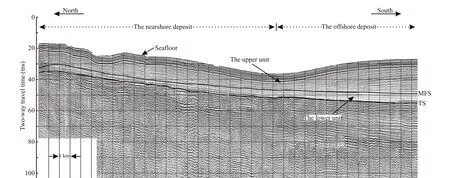
Fig.4 Typical north-south shallow seismic profile (location shown in Fig.1b), which cross the nearshore and off shore deposits
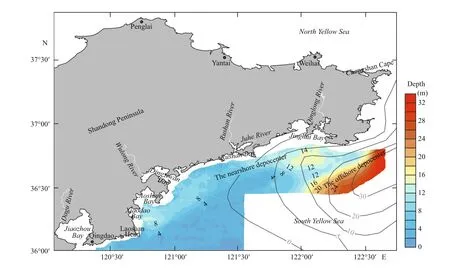
Fig.5 Isopach map of Holocene mud indicates two depocenters in the Yellow Sea
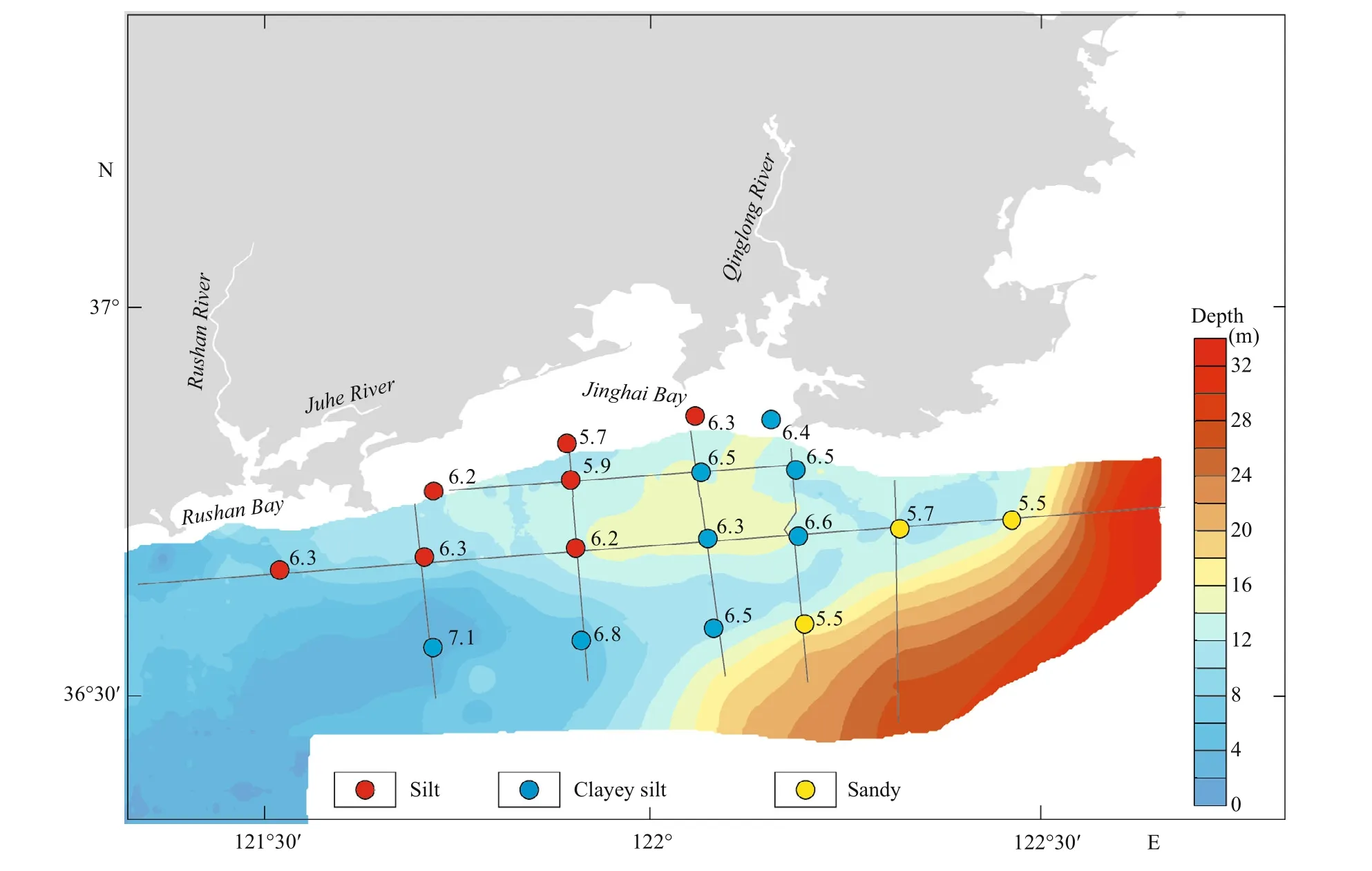
Fig.6 Spatial distribution maps of silt, clayey silt, and sandy silt surface sediment types in this study area
The surface sediment types in this area can be divided into silt, clayey silt, and sandy silt (Fig.6). At the mouth of Jinghai Bay, the sediments are mainly silt and become finer seaward, changing to clayey silt,but become coarser sandy silt at the western boundary of the off shore depocenter, indicating energetic physical conditions. Grain size is similar to that of core QDZ03. Core QDZ03 can also be divided into the upper and lower unit corresponding to the seismic profile (Fig.7). The upper unit of core QDZ03 is mainly composed of green-gray and yellow-greengray clayey silt that contain sporadic shell fragments.The lower part (4.80–7.70 m) has very uniform grain sizes, with mean values from 6.9 to 7.2 Φ (7.0 Φ on average), whereas the sediment above 4.80 m has a wider range in mean grain sizes from 5.8 to 7.2 Φ and a slightly coarser average as a whole (6.6 Φ on average), and the lower unit is mainly composed of green and yellow-gray clayey silt intercalated with lenticular beds and thin bands of silt or fine sand.These coarser-grained intercalated bands decrease upward gradually, showing a normal grading. The mean grain size is 6.0 Φ. Sporadic shell fragments and moderate bioturbation are present (Qiu et al.,2014). So the main body of the mud deposits is composed of fine sediments.
The Holocene mud deposit from core WHZK01 can also be divided into the upper unit and the lower unit by the MFS (Fig.8). The upper unit is mainly composed of gray clayey silt and silt and the lower unit is mainly composed of gray-yellow silt sand and clayey silt (Liu, 2016).
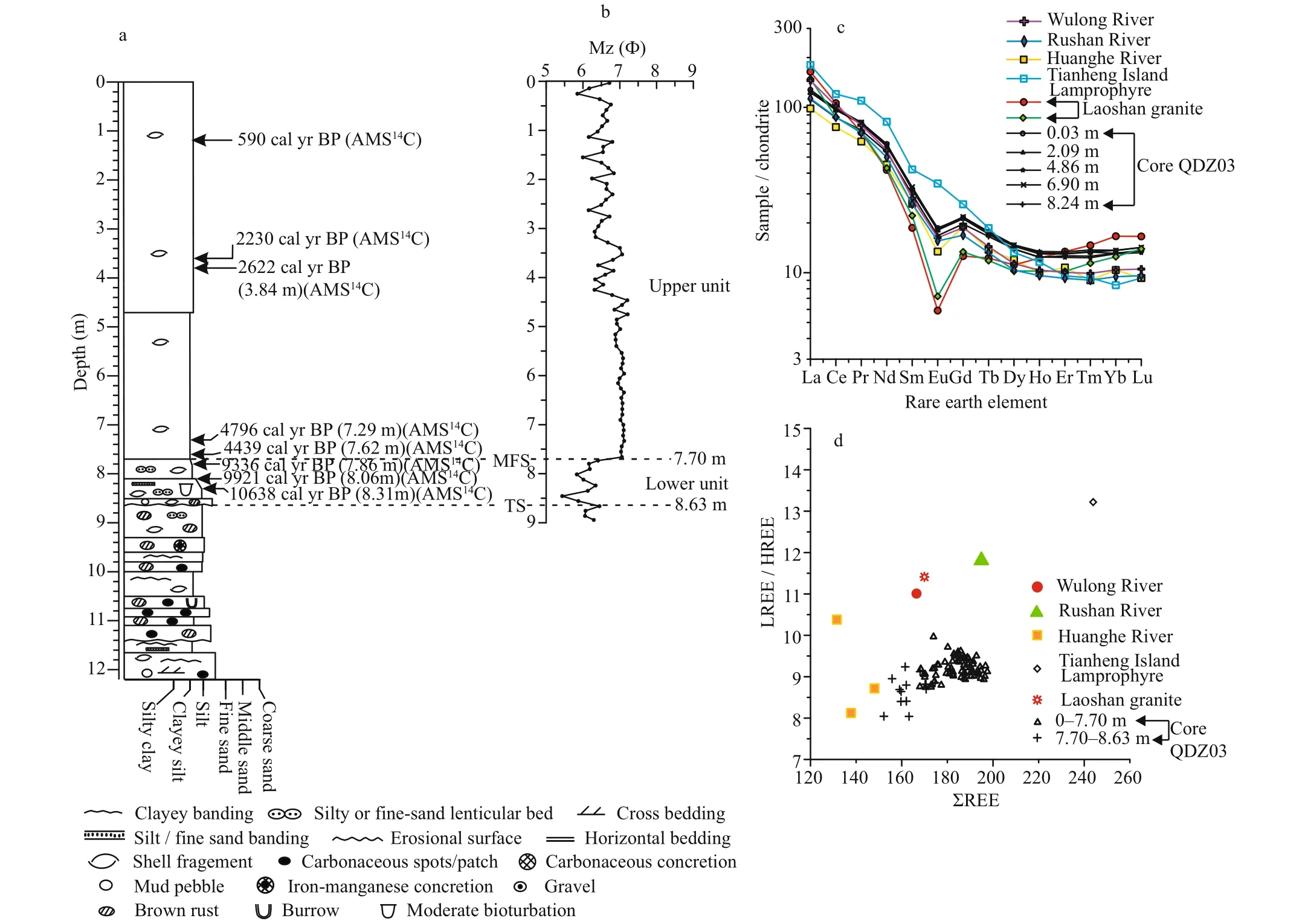
Fig.7 Lithologic column from core QDZ03 with AMS 14 C dates (0–12 m) (a), distribution of mean grain size (Mz) (b), pattern of chondrite-normalized REE (c) and REE-LREE/HREE diagram (d) of representative samples from 0–9 m interval of core QDZ03 (modified from Qiu et al., 2014)
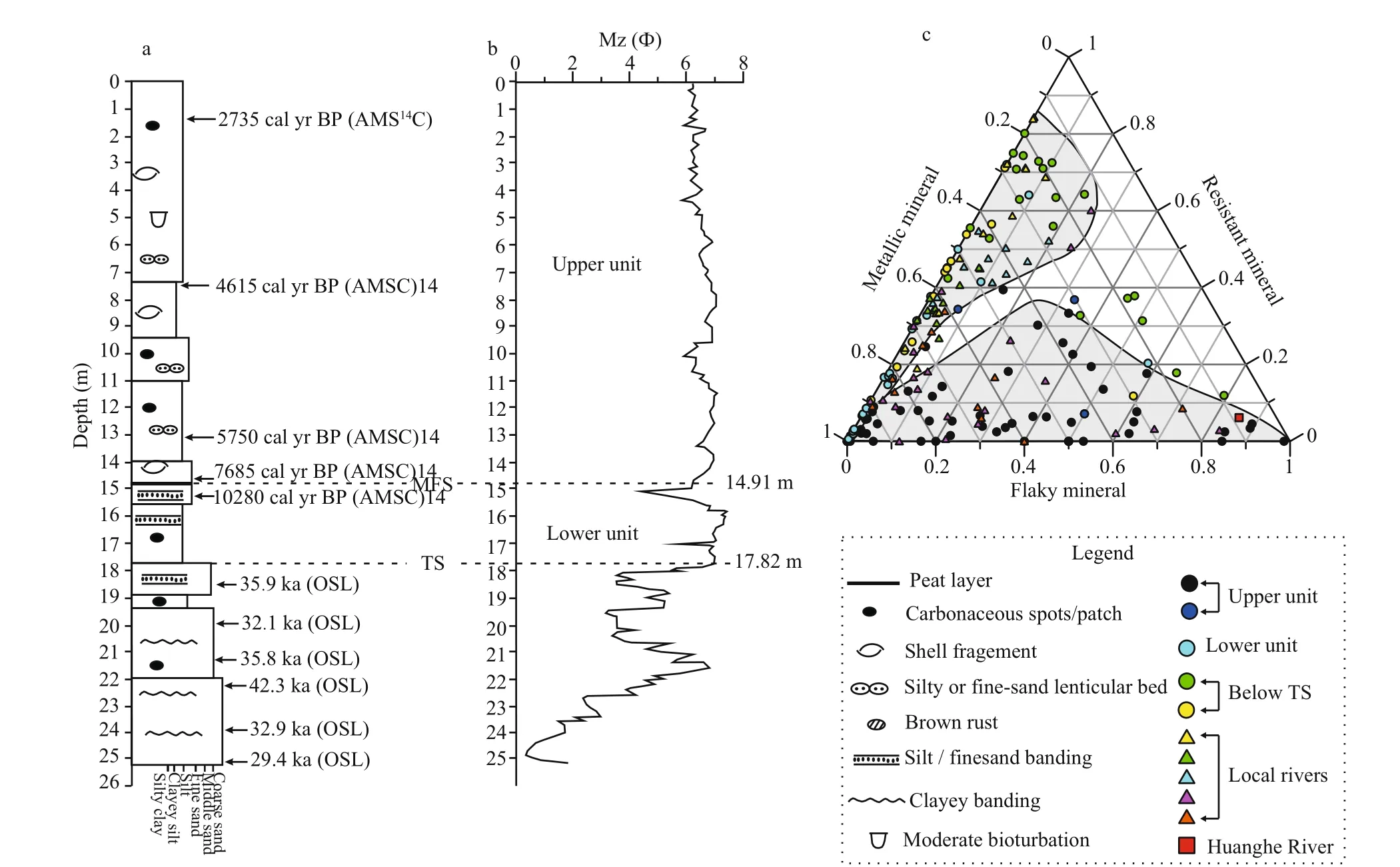
Fig.8 Lithologic column from core WHZK01 with AMS 14 C and OSL dates (a), distribution of mean grain size (Mz) (b) and mineral ternary diagram showing compositions from core WHZK01, local rivers and Huanghe River (c) (modified from Liu, 2016)
5 DISCUSSION
Numerous studies have found a rapid deposition and accumulation center near many large river mouths worldwide, such as the Ganges-Brahmaputra (Kuehl et al., 1997) and Huanghe Rivers (Bornhold et al.,1986). However, smaller rivers also play important roles in the transfer of terrigenous sediment to the global ocean (Milliman and Syvitski, 1992) and can have profound impacts on both short-term and longterm characters of a coast (Syvitski and Saito, 2007)and seafloor (Milliman et al., 2007).
As with mud deposits elsewhere (Lee and Chu,2001; Weight et al., 2011), development of the mud deposits in this study area resulted from multiple factors such as sea-level changes, sediment sources,and sedimentary dynamic conditions. During the Last Glacial Maximum, sea level was 120 m below the present level and the Yellow Sea shelf was entirely subaerially exposed (Liu et al., 2004). With the postglacial sea-level rise, the shoreface moved landward across the shelf, forming the regional transgressive surface, which initially formed around 11 ka in the study area (Qiu et al., 2014). The mud deposits formed during the Holocene because they directly overlie the transgressive surface.
According to the AMS14C dates of cores QDZ03 and WHZK01 (Figs.7 and 8), the lower unit of the deposit formed between 11 and 9 kyrs, which agrees with the formation time of the proximal sequence of the Shandong subaqueous clinoform (Liu et al.,2004). From about 11.6 to 11.3 kyrs, sea level jumped from about -58 m to -43 m in response to the Meltwater Pulse (MWP)-1B event (Liu et al., 2004), which was followed by stagnating sea level rise (from -42 m to-38 m) for about 1.8 kyrs (Fairbanks et al., 1989). We suggest it was during this period 1.8-kyrs interval(11–9.2 kyrs) of slow-rising sea level and increased local rivers and Huanghe River discharge that the lower unit of the deposit accreted over the transgressive surface. When the transgressive surface initially formed around 11 kyrs, the sea level stood at about-40 m (Liu et al., 2004), where maybe the location of the local rivers mouth, so the sediments from local rivers on the Shandong Peninsula can be emptied into sea directly, combined with the proximal sediments from Huanghe River, formed the lower unit of the off shore deposit. Beginning 9.8 kyrs, sea level again rose rapidly, from 36 to 16 m in 800 years. When the nearshore area was merged gradually and the lower unit of the nearshore deposit was formed in a subtidal environment. Because of the landward of local small rivers mouth and the Huanghe River diverted to the Jiangsu coast south of the Shandong Peninsula, the sedimentation rate was relatively low.
During the middle Holocene, about 6.5 kyrs, the Yellow Sea Warm Current and the modern circulation pattern formed (Liu et al., 1999; Li et al., 2007),sediments from rivers on the Shandong Peninsula poured into Jinghai, Rushan, Dingziwan, Aoshan, and Xiaodao bays, formed sedimentary fans at their mouths. At the same time, sediments were influenced by coastal currents that carried Huanghe Riverderived sediments to this area, as evidenced by sediment geochemistry of core QDZ03 (Qiu et al.,2014) and the surface sediments (Zhang et al., 2014)(Fig.7). Besides, comparison of heavy minerals, clay minerals and XRF scanning elements among the sediment of the core WHZK01, the surface sediment from Rushan River, Qinglong River and Huanghe River-derived sediment also suggest that the provenance of the upper unit is the joint contribution from the local small rivers and Huanghe River (Liu,2016). Suspended sediment concentrations along the Shandong Peninsula can also verify plume transport from the Bohai Sea to the Yellow Sea (Qin et al.,1989a; Martin et al., 1993). All of these comprise sources of the upper unit of the nearshore deposit.
The Huanghe River discharged mostly or entirely into the Bohai Sea in the past 7 ka, except during the 1128–1855 AD, when it shifted to the south (Saito et al, 2001). Extensive geological and geophysical surveys conducted in the Yellow Sea indicate that the upper unit of the off shore deposit is a continuous sediment body connecting to the along-shelf clinoform off the northern Shandong Peninsula (Liu et al., 2004;Yang and Liu, 2007), so there is no doubt that it is mainly Huanghe River-derived. The formation time,in the past 7 ka, is the same as the thick mud mound belonging to the highstand system tract at the eastern tip of the Shandong Peninsula (Yang and Liu, 2007).Based on the thickness of the mud distribution, using the Volume tools in Surfer 11, we calculate the total volume of the nearshore deposit is about 4.97× 1010m3or 6.0× 1010tons (assuming a dry density of 1.2 t/m3)(Chen et al., 2003).
Assuming a relatively constant sediment discharge of 50 × 104t/a for the Rushan River into Rushan Bay,84× 104t/a for the Wulong River into Dingziwan Bay,and 3.9× 104t/a for small rivers into Aoshan Bay and Xiaodao Bay (Editorial Board of Annals of Bays in China, 1993), approximately 1.5× 1010tons of sediment were emptied into the bays by the rivers during the development of the clinoform within the last 11.0 ka. This estimate of sediment discharges can be considered a maximum because present fluvial sediment loads are higher than those of ca. 2000 years BP because of human activities, as evidenced by the cases of the Yangtze River and Huanghe River (Saito et al., 2001). Moreover, the estimated sediment discharge (1.5× 1010tons) must have included sediments that were deposited in bays in addition to those transported out of the bays to the clinoform by tides, waves, and alongshore currents. The implication is that the total amount of sediment (about 6.0× 1010tons) in the clinoform must have come from other sources in addition to the local small rivers.These sources likely include the Huanghe River.Marine currents in the region transport sediments from the Huanghe River through the Bohai Strait and along the coast of the Shandong Peninsula to the study area (Fig.5).
The linear depression between the two depocenters may be because of local strong dynamics. It indicates a boundary for the subaqueous delta off the Shandong Peninsula. It may be related to the strong shear stresses (Pirmez et al., 1998) caused by strong tidal currents, similar to conditions at the eastern tip of the Shandong Peninsula (Yang and Liu, 2007). The area may also suff er erosion due to local complex current regimes. This agrees with the grain size distribution:sandy silt occurs in the depression, which is surrounded by finer sediment (silt or clayey silt).
6 CONCLUSION
Newly acquired high-resolution seismic profiles reveal two mud depocenters off the southern Shandong Peninsula in the Yellow Sea, which have diff erent sedimentary architectures and can be divided into upper and lower units by the Holocene maximum flooding surface. Between the two depocenters is a linear depression. The source of the nearshore deposit is the joint contribution from the local small rivers on the Shandong Peninsula and Huanghe River. The upper unit of the nearshore deposit belongs to the highstand system tract and the lower unit belongs to the transgressive system tract. The upper unit of the off shore deposit belongs to the highstand system tract and connects to the along-shelf clinoform off the northeastern Shandong Peninsula. The lower unit of the off shore deposit belongs to the transgressive system tract and is characterized by aggradation. The linear depression combines the two deposits and indicates the boundary of the subaqueous delta off the Shandong Peninsula.
7 DATA AVAILABILITY STATEMENT
The data that support the findings of this study are available from the corresponding author upon reasonable request.
8 ACKNOWLEDGEMENT
We are grateful to HE Qixiang for his help in the preparation of this manuscript.
Alexander C R, DeMaster D J, Nittrouer C A. 1991. Sediment accumulation in a modern epicontinental-shelf setting: the Yellow Sea. Mar. Geol., 98(1): 51-72.
Anthony E J, Gardel A, Gratiot N, Proisy C, Allison M A,Dolique F, Fromard F. 2010. The Amazon-influenced muddy coast of South America: a review of mud-bankshoreline interactions. Earth Sci. Rev., 103(3-4): 99-121.
Bornhold B D, Yang Z S, Keller G H, Prior D B, Wiseman W J, Wang Q, Wright L D, Xu W D, Zhuang Z Y. 1986.Sedimentary framework of the modern Huanghe(Huanghe River) Delta. Geo- Mar. Lett., 6(2): 77-83.
Chen Z Y, Saito Y, Hori K, Zhao Y W, Kitamura A. 2003. Early Holocene mud-ridge formation in the Yangtze off shore,China: a tidal-controlled estuarine pattern and sea-level implications. Mar. Geol., 198(3-4): 245-257.
Cheng P, Gao S, Liu J P, Guan C Z, Wang G Z, Milliman J D.2001. A preliminary study of the distribution of Holocene deposits in the western North Yellow Sea. Quat. Sci.,21(4): 379. (in Chinese)
Curran K J, Hill P S, Milligan T G. 2002. Fine-grained suspended sediment dynamics in the Eel River flood plume. Cont. Shelf. Res., 22(17): 2 537-2 550.
Editorial Board of Annals of Bays in China. 1993. Annals of Bays in China (Series 4). China Ocean Press, Beijing,China. 73p. (in Chinese)
Fairbanks R G. 1989. A 17,000-year glacio-eustatic sea level record: influence of glacial melting rates on the Younger Dryas event and deep-ocean circulation. Nature,342(6250): 637-642.
Gao S, Collins M B. 2014. Holocene sedimentary systems on continental shelves. Mar. Geol., 352: 268-294.
Gerber T P, Pratson L F, Kuehl S, Walsh J P, Alexander C,Palmer A. 2010. The influence of sea level and tectonics on Late Pleistocene through Holocene sediment storage along the high-sediment supply Waipaoa continental shelf. Mar. Geol., 270(1-4): 139-159.
Kuehl S A, Levy B M, Moore W S, Allison M A. 1997.
Subaqueous delta of the Ganges-Brahmaputra river system. Mar. Geo l., 144(1-3): 81-96.
Lee H J, Chu Y S. 2001. Origin of inner-shelf mud deposit in the southeastern Yellow Sea: Huksan Mud Belt. J.Sediment. Res., 71(1): 144-154.
Li T G, Jiang B, Sun R T, Zhang D Y, Liu Z X, Li Q. 2007.Evolution pattern of warm current system of the East China Sea and the Yellow Sea since the last deglaciation.Quat. Sci., 27(6): 945-954. (in Chinese with English abstract)
Liu J. 2016. Provenance and Sedimentary Evolution of the Muddy Area in the Southern Shandong Peninsula. Ocean University of China, Qingdao, China. (in Chinese with English abstract)
Liu J, Li S Q, Wang S J, Yang Z G, Ge Z S, Chang J H. 1999.Sea level changes of the Yellow Sea and formation of the Yellow Sea warm current since the last deglaciation. Mar.Geol. Quat. Geol., 19(1): 13-24. (in Chinese with English abstract)
Liu J, Saito Y, Wang H, Yang Z G, Nakashima R. 2007.Sedimentary evolution of the Holocene subaqueous clinoform off the Shandong Peninsula in the Yellow Sea.Mar. Geol., 236(3-4): 165-187.
Liu J P, Milliman J D, Gao S. 2002. The Shandong mud wedge and post-glacial sediment accumulation in the Yellow Sea. Geo- Mar. Lett., 21(4): 212-218.
Liu J P, Milliman J D, Gao S, Cheng P. 2004. Holocene development of the Huanghe River’s subaqueous delta,North Yellow Sea. Mar. Geol., 209(1-4): 45-67.
Liu J Q, Yin P, Chen X Y, Cao Z M, Wang S T, Wu Z, Song W.2016. Sedimentary environmental evolution of mud area off the southern coast of Weihai since Late Pleistocene.Mar. Geol. Quat. Geol., 36(6): 199-209. (in Chinese with English abstract)
Martin J M, Zhang J, Shi M C, Zhou Q. 1993. Actual flux of the Huanghe (Huanghe River) sediment to the western Pacific Ocean. Neth. J. Sea Res., 31(3): 243-254.
Milliman J D, Lin S W, Kao S J, Liu J P, Liu C S, Chiu J K, Lin Y C. 2007. Short-term changes in seafloor character due to flood-derived hyperpycnal discharge: Typhoon Mindulle, Taiwan, July 2004. Geology, 35(9): 779-782.
Milliman J D, Qin Y S, Park Y A. 1989. Sediments and sedimentary processes in the Yellow and East China Seas.In: Taira A, Masuda F eds. Sedimentary Facies in the Active Plate Margin. Terra Scientific Publishing Company,Tokyo, Japan. p.233-249.
Milliman J D, Syvitski J P M. 1992. Geomorphic/tectonic control of sediment discharge to the ocean: the importance of small mountainous rivers. J. Geo l., 100(5): 525-544.
Niedoroda A W, Reed C W, Das H, Fagherazzi S, Donoghue J F, Cattaneo A. 2005. Analyses of a large-scale depositional clinoformal wedge along the Italian Adriatic coast. Mar.Geol., 222- 223: 179-192.
Owen R B. 2005. Modern fine-grained sedimentation—spatial variability and environmental controls on an inner pericontinental shelf, Hong Kong. Mar. Geol., 214(1-3):1-26.
Pirmez C, Pratson L F, Steckler M S. 1998. Clinoform development by advection-diff usion of suspended sediment: modeling and comparison to natural systems. J.Geoph ys. Res., 103(B10): 24 141-24 157.
Qin Y S, Li F. 1986. Study of the influence of sediment loads discharged from the Huanghe River on sedimentation in the Bohai and Yellow Seas. Stud. Mar. Sin., 27: 125-135.(in Chinese with English abstract)
Qin Y S, Li F, Xu S, Milliman J, Limeburner R. 1989a.Suspended matter in the South Yellow Sea. Oceanol.Limnol. Sinica, 20(2): 101-112. (in Chinese with English abstract)
Qin Y S, Zhao Y Y, Chen L R, Zhao S L. 1989b. Geology of the Yellow Sea. China Ocean Press, Beijing, China. 24p. (in Chinese)
Qiu J D, Liu J, Saito Y, Yang Z G, Yue B J, Wang H, Kong X H. 2014. Sedimentary evolution of the Holocene subaqueous clinoform off the southern Shandong Peninsula in the western South Yellow Sea. J. Ocean Univ. China, 13(5): 747-760.
Riboulot V, Cattaneo A, Berné S, Schneider R R, Voisset M,Imbert P, Grimaud S. 2012. Geometry and chronology of late Quaternary depositional sequences in the Eastern Niger Submarine Delta. Mar. Geol., 319- 322: 1-20.
Saito Y, Yang Z S, Hori K. 2001. The Huanghe (Huanghe River) and Changjiang (Yangtze River) deltas: a review on their characteristics, evolution and sediment discharge during the Holocene. Geomorphology, 41(2-3): 219-231.
Syvitski J P M, Saito Y. 2007. Morphodynamics of deltas under the influence of humans. Glob al Planet. Chang,57(3-4): 261-282.
Tamura T, Saito Y, Bateman M D, Nguyen V L, Ta T K O,Matsumoto D. 2012. Luminescence dating of beach ridges for characterizing multi-decadal to centennial deltaic shoreline changes during Late Holocene, Mekong River delta. Mar. Geol., 326- 328: 140-153.
van Maren D S. 2005. Barrier formation on an actively prograding delta system: the Red River Delta, Vietnam.Mar. Geol., 224(1-4): 123-143.
Wang Y H, Li G X, Zhang W G, Dong P. 2014. Sedimentary environment and formation mechanism of the mud deposit in the central South Yellow Sea during the past 40 kyr. Mar. Geol., 347: 123-135.
Weight R W R, Anderson J B, Fernandez R. 2011. Rapid mud accumulation on the central Texas shelf linked to climate change and sea-level rise. J. Sediment. Res., 8 1(10): 743-764.
Xu K H, Li A C, Liu J P, Milliman J D, Yang Z H, Liu C S, Kao S J, Wan S M, Xu F J. 2012. Provenance, structure, and formation of the mud wedge along inner continental shelf of the East China Sea: a synthesis of the Yangtze dispersal system. Mar. Geol., 291- 294: 176-191.
Yang Z S, Liu J P. 2007. A unique Huanghe River-derived distal subaqueous delta in the Yellow Sea. Mar. Geol.,2 40(1-4): 169-176.
Zhang R S. 1984. Land-forming history of the Huanghe River Delta and coastal plain of North Jiangsu. Acta Geogr.Sin., 39(2): 173-184. (in Chinese with English abstract)
Zhang X B, Zhang Y, Kong X H, Li A L, Liu S S, Chu H X, Lin M M. 2014. Rare earth elements analysis for provenance study of surface sediments off south Shandong Peninsula.Mar. Geol. Quat. Geol., 34(3): 57-66. (in Chinese with English abstract)
猜你喜欢
杂志排行
Journal of Oceanology and Limnology的其它文章
- Editorial Statement
- Ferroan dolomites in Miocene sediments of the Xisha Islands and their genetic model*
- Synchronous response of sedimentary organic carbon accumulation on the inner shelf of the East China Sea to the water impoundment of Three Gorges and Gezhouba Dams*
- Rates and fluxes of centennial-scale carbon storage in the fine-grained sediments from the central South Yellow Sea and Min-Zhe belt, East China Sea*
- Centennial-scale records of total organic carbon in sediment cores from the South Yellow Sea, China*
- Century-scale high-resolution black carbon records in sediment cores from the South Yellow Sea, China*
